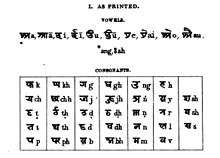Kaithi
| Kaithī Kayathi, Kayasthi | |
|---|---|
 | |
| Type | |
| Languages | Angika, Awadhi, Bhojpuri, Braj Bhasha, Caribbean Hindustani, Fiji Hindi, Magahi, Maithili, Hindi, Urdu |
Time period | c. 16th–mid 20th century |
Parent systems | |
Sister systems | Devanagari, Nandinagari |
| Direction | Left-to-right |
| ISO 15924 |
Kthi, 317 |
Unicode alias | Kaithi |
| U+11080–U+110CF | |
Kaithi, also called "Kayathi" or "Kayasthi", is a historical script used widely in parts of North India, primarily in the former North-Western Provinces, Awadh and Bhojpur, and Madhesh in Nepal. It was used for writing legal, administrative, and private records.[1]
Etymology
Kaithi script derives its name from the word Kayastha, a social group of India that traditionally consists of administrators and accountants.[2] The Kayastha community was closely associated with the princely courts and colonial governments of North India, and were employed by them to write and maintain records of revenue transactions, legal documents, and title deeds; general correspondence; and proceedings of the royal courts and related bodies.[3] The script used by them acquired the name Kaithi.
History

Documents in Kaithi are traceable to at least the 16th century. The script was widely used during the Mughal period. In the 1880s, during the British Raj, the script was recognized as the official script of the law courts of Bihar. Although in general, Kaithi was much more widely used than Devanagari in some areas, it later on lost its popularity to the other officially-recognized scripts.
Unicode
Kaithi script was added to the Unicode Standard in October, 2009 with the release of version 5.2.
The Unicode block for Kaithi is U+11080–U+110CF:
| Kaithi[1][2] Official Unicode Consortium code chart (PDF) | ||||||||||||||||
| 0 | 1 | 2 | 3 | 4 | 5 | 6 | 7 | 8 | 9 | A | B | C | D | E | F | |
| U+1108x | 𑂀 | 𑂁 | 𑂂 | 𑂃 | 𑂄 | 𑂅 | 𑂆 | 𑂇 | 𑂈 | 𑂉 | 𑂊 | 𑂋 | 𑂌 | 𑂍 | 𑂎 | 𑂏 |
| U+1109x | 𑂐 | 𑂑 | 𑂒 | 𑂓 | 𑂔 | 𑂕 | 𑂖 | 𑂗 | 𑂘 | 𑂙 | 𑂚 | 𑂛 | 𑂜 | 𑂝 | 𑂞 | 𑂟 |
| U+110Ax | 𑂠 | 𑂡 | 𑂢 | 𑂣 | 𑂤 | 𑂥 | 𑂦 | 𑂧 | 𑂨 | 𑂩 | 𑂪 | 𑂫 | 𑂬 | 𑂭 | 𑂮 | 𑂯 |
| U+110Bx | 𑂰 | 𑂱 | 𑂲 | 𑂳 | 𑂴 | 𑂵 | 𑂶 | 𑂷 | 𑂸 | 𑂹 | 𑂺 | 𑂻 | 𑂼 | | 𑂾 | 𑂿 |
| U+110Cx | 𑃀 | 𑃁 | ||||||||||||||
| Notes | ||||||||||||||||
References
- ↑ King, Christopher R. 1995. One Language, Two Scripts: The Hindi Movement in Nineteenth Century North India. New York: Oxford University Press.
- ↑ Grierson, George A. 1899. A Handbook to the Kaithi Character. Calcutta: Thacker, Spink & Co.
- ↑ Pandey, Anshuman. 2008. "Proposal to Encode the Kaithi Script in ISO/IEC 10646"